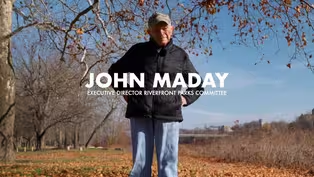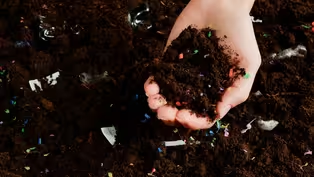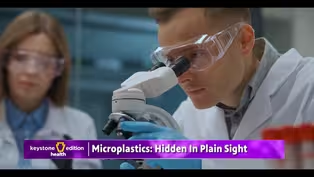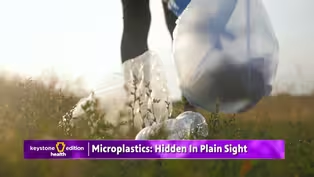Keystone Edition
Microplastics - Suggestions and Solutions
Clip: 12/16/2024 | 12m 31sVideo has Closed Captions
See a citizen science project testing Pennsylvania waterways for microplastics,
See a citizen science project testing Pennsylvania waterways for microplastics, revealing widespread contamination. Experts discuss the plastic lifecycle, from fracking to disposal, and the dangers of chemicals leaching from plastics. Recommendations include avoiding plastic use, advocating for bans on single-use plastics, and choosing sustainable alternatives to protect health and the environment
Problems playing video? | Closed Captioning Feedback
Problems playing video? | Closed Captioning Feedback
Keystone Edition is a local public television program presented by WVIA
Keystone Edition
Microplastics - Suggestions and Solutions
Clip: 12/16/2024 | 12m 31sVideo has Closed Captions
See a citizen science project testing Pennsylvania waterways for microplastics, revealing widespread contamination. Experts discuss the plastic lifecycle, from fracking to disposal, and the dangers of chemicals leaching from plastics. Recommendations include avoiding plastic use, advocating for bans on single-use plastics, and choosing sustainable alternatives to protect health and the environment
Problems playing video? | Closed Captioning Feedback
How to Watch Keystone Edition
Keystone Edition is available to stream on pbs.org and the free PBS App, available on iPhone, Apple TV, Android TV, Android smartphones, Amazon Fire TV, Amazon Fire Tablet, Roku, Samsung Smart TV, and Vizio.
Providing Support for PBS.org
Learn Moreabout PBS online sponsorship(logo whooshes) - Faran, I think this is a great transition to talk about your program.
Can you tell us a little bit about this community driven science program where you were collecting samples of water?
- Sure.
So our work testing for microplastics is really a citizen science driven program 'cause a lot of our work at PennEnvironment focuses on advocacy, on solutions, on trying to create the policy changes.
But our microplastics work, we know that Pennsylvanians care deeply about their rivers and streams.
It's where we fish, it's where our kids play, it's where we boat.
They're sort of the lifeblood of our communities.
And so we did this citizen science project where our staff, our interns, our volunteers went out and collected water samples from all around the state.
We involved local fishing groups and recreation groups.
We got state and federal officials to come out and test waterways with us.
And then we took those samples back and we filtered them and analyzed them for microplastics.
And it's a great way to really get people to connect with this problem of plastic pollution.
'Cause a lot of times we think about it as a litter problem, as a problem maybe for sea turtles and whales, but when we really see the plastic pollution at home in the waterways that run through our yards or that we walk along every day, it connects us to them and makes it that much more important that we do strive for some of these solutions to actually work upstream and tackle the sources of plastic that are becoming microplastics and polluting these waterways too.
- Yeah, I think when you personalize then it gives me or Andrea a responsibility, right?
- [Faran] Of course.
Yeah.
- Ned, as the president of Physicians for Social Responsibility, Pennsylvania, you're obviously not just looking at plastics, but where these plastics come from.
Can you speak to us a little bit about that?
- Well, the life of plastics begins at the wellhead where oil and gas is fracked.
And here in Pennsylvania there's an awful lot of fracking going on, especially where I live in southwestern Pennsylvania.
Ethane and methane are the gases that are fracked out of the ground.
The ethane is cracked at an ethane cracker facility like the Shell Plant in Beaver County, Pennsylvania, which is an enormous plant.
Ethane is cracked into ethylene and then that's polymerized into polyethylene pellets, which are small plastic pellets or nodules that are then sent to plastics factories to make new plastic products, especially single use plastic.
So that's where plastic is born at the wellhead.
And so there are an awful lot of health problems associated with fracking that we're observing here in southwestern Pennsylvania and in northeastern Pennsylvania where fracking is occurring.
Pennsylvania is a fracking state and that doesn't seem to change or it's not gonna change anytime soon.
But residents of Pennsylvania around fracked gas are getting sick and seriously so.
And we're seeing the same types of illnesses around the cracker plant.
So, you know, from start to end, from its beginning to its end in landfills, in our oceans, in streams, in soil, plastic is very dangerous and is harming health.
- If I could- - Oh, go ahead, please.
- I'll be real quick.
- Absolutely.
- Just to put a finer point on it, it really gives Pennsylvania an extra responsibility when it comes to the plastic that we create and use because really at every step of its lifecycle, from when we extract the chemicals and the fossil fuels from the ground to when we turn 'em into plastic products, to when we use them and then dispose of them, we're creating harm for our environment and our health too.
And not a lot of other states can say that.
And so we really see these problems firsthand and experience them in a lot of other ways that go beyond just the waste.
- Yeah.
We're part of the entire life cycle.
- Yes.
- Unfortunately.
I wanna talk a little bit about end use because we've already spoken about how BPA free basically means nothing, or we won't say nothing, but almost nothing.
But I also wanna talk about how people use plastic in their home because a lot of people are putting it in microwaves, not just storing food in it.
And what happens when you heat plastic or maybe even setting at room temperature.
- Exactly.
Yeah.
So the higher risk is when the plastic is exposed to light, UV light, then you know, then all of the chemicals can leach into, let's say a water bottle.
But also if on the plastic we see that is microwave safe or dish water safe, that means that it has more chemicals in the plastic.
And as we heat or we use very hot water on these, these plastics are going to leach into the water.
And if there is food, it is going to leach into the food.
So we are so used to have use plastics for almost everything in our lives.
And I also want to point out that our clothes are made of plastic, our furniture is made of plastic, so it's not only the plastic that we see, but maybe the plastic that we don't see, or we assume that is not plastic, it's, you know, damaging.
And also I want to point out something else.
We kind of think that the plastic is recyclable and some of it is, but in reality we recycle very little.
So we do our best in our homes to actually, you know, sort that and you know, give it to the recycling company.
But in reality we do not know if that is recycled in the end or not.
- I know that you all work on some policy efforts towards eradicating plastic in our community.
Can you speak a little bit about that and also let people know how they could do similar things in their communities?
- Yeah, we really try and push for upstream solutions when it comes to plastic pollution because yeah, recycling plastic is really, really challenging.
And if it's going to our landfills, it's creating microplastics.
And so the best thing we can do is not create the plastic in the first place.
If we stop it from becoming, if we stop it from getting to consumers, if we stop it from becoming waste in the first place, we don't have to find a sustainable solution.
And so we have seen this work in other states around the country.
One of the best solutions is to pass legislation banning types of single use plastics.
Things like plastic bags, styrofoam containers, plastic straws and utensils.
We use 'em for a couple minutes, we throw 'em away, but they're gonna last for a long, long time and have impacts that go far beyond that.
But they're easily replaceable.
We have reusable and sustainable alternatives that we can turn to instead.
And sometimes it does take that legislative push to get people to start using those reusable alternatives.
We're seeing them more and more in Pennsylvania.
There are now 35 bans on single use plastics across the state, including our two largest cities.
Momentum is building, but it does, it is important for our local communities to step up, stand up and say, we've had enough of plastic waste, it's time to get rid of it.
And the best thing we can do is go with an upstream solution and try and cut it off at the source.
- I heard recently a story about an organization that's actually helping restaurants transition to cardboard and away from plastic.
I wish I'd saved that name so we could say it now.
Ned, as a retired pediatrician, I'm now thinking about the fact that kids always used to drink out of plastic bottles or they had those little plastic inserts that you put in bottles that were disposable.
How do plastics impact a newborn and is it going to be much worse than what would happen to an adult?
- So a lot of these chemicals that are added to plastics act as endocrine disrupting chemicals and they act at extremely low concentrations.
So these chemicals get into the bloodstream during pregnancy, when a fetus is developing, in early infancy and in childhood.
And that's really the most vulnerable time in life is when organs are developing, fetuses and infants are growing and developing, brain development is happening quickly.
And when when you're ingesting or inhaling chemicals that can interfere with your endocrine system, with your hormones, it interferes with the growth and development of growing children.
And so children happen to be extremely vulnerable to these chemicals.
It's not so much that the dose makes the poison, really the timing that makes the poison.
And when you know fetuses and children and infants are exposed to these chemicals, they seem to have the the worst consequences.
- I was wondering, you talked about testing waterways.
Did you all test tap water?
'Cause I can't help but wonder if there might be plastics, microplastics in my water at home as well.
- We have tested tap water samples from a couple different cities, including Philadelphia, Allentown, Bethlehem, and Easton.
Unfortunately, we did find microplastics in our tap water.
These particles are so small that despite all the filtration and water treatment that happens, and despite using maybe a Brita filter or an at-home filter, there's still microplastics that can get through and can get into the drinking water.
That isn't to say you shouldn't drink the tap water.
Certainly if you're drinking bottled water, which is in a plastic bottle, that bottling process is gonna put magnitudes more plastic into your drinking water.
So it's certainly better to stick with tap water to use reusable bottles rather than go with those single use plastic ones if you're gonna avoid microplastics.
But there are still going to be some microplastics that make it in carrying chemicals with them and potentially damaging our health.
- Yeah, after my conversation with you, actually, I was going to buy a Brita filter for my fridge, one of the large ones, and instead I ended up buying glass refillable bottles.
Are there any last recommendations that you would have for folks around plastics in their home and how to avoid them as well?
- Yeah, that's a great question.
So indeed, you know, starting from drinking water, using a glass bottle or you know, stainless steel bottle would be great.
However, there is, we cannot kind of protect ourself from plastic, but we can diminish the amount of the plastic that we breathe or ingest or you know, how much it is absorbed through the skin.
So therefore, I would always suggest, you know, instead of using, you know, plastic utensils or plates or anything that is made of plastic and it is used for as a food container, I would suggest everyone to avoid that.
And by doing so, we also lower the demand on the market.
So therefore there is going to be less produced.
We hope for that.
Other things that we could try, you know, in our clothes, we are going to just to become, not necessarily minimalist, but you know, be more conscious about how much stuff we purchase.
And we don't need that much.
So that's why if we can actually have less and use it more, if we could use, you know, more natural fibers, that would be great.
If we would try to use as furniture, you know, made of wood instead of made of different layers of maybe, you know, small particles of wood and plastics, that would be great as well.
- I love that you talk about that.
It goes right in line with what you were saying about zero waste, and I thank you for sharing that.
Microplastics and Community Action: Restoring Our Rivers
Video has Closed Captions
Clip: 12/16/2024 | 2m 56s | Explore how you can make a difference for our waterways and planet. (2m 56s)
Microplastics: Hidden in Plain Sight - Preview
Preview: 12/16/2024 | 30s | Watch Monday, December 16th at 7pm on WVIA TV (30s)
Uncovering the Dangers of Microplastics
Clip: 12/16/2024 | 8m 21s | Experts explain the dangers of microplastics—tiny plastic particles found in food, water, and air. (8m 21s)
Providing Support for PBS.org
Learn Moreabout PBS online sponsorship
- News and Public Affairs

Top journalists deliver compelling original analysis of the hour's headlines.

- News and Public Affairs

FRONTLINE is investigative journalism that questions, explains and changes our world.












Support for PBS provided by:
Keystone Edition is a local public television program presented by WVIA



